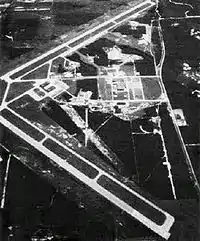Naval Weapons Industrial Reserve Plant, Calverton
Naval Weapons Industrial Reserve Plant, Calverton (NWIRP) was a government-owned, contractor-operated (GOCO) facility which had the mission of designing, fabricating, and testing prototype aircraft from 1956 until 1996, in Riverhead, New York.
| Naval Weapons Industrial Reserve Plant, Calverton | |
|---|---|
| Part of United States Navy | |
| Riverhead, New York | |
| Coordinates | 40°54′45″N 72°47′44″W |
| Type | Aircraft Manufacturing Plant |
| Site information | |
| Controlled by | Navy |
| Open to the public | Partially |
| Site history | |
| In use | 1956–1996 |
Calverton Executive Airpark | |||||||||||||||
|---|---|---|---|---|---|---|---|---|---|---|---|---|---|---|---|
 Calverton in 1979–1980 | |||||||||||||||
| Summary | |||||||||||||||
| Airport type | Public-owned, Private-use | ||||||||||||||
| Owner | Town of Riverhead | ||||||||||||||
| Location | Calverton, New York | ||||||||||||||
| Elevation AMSL | 75 ft / 23 m | ||||||||||||||
| Coordinates | 40°54′54″N 072°47′31″W | ||||||||||||||
| Runways | |||||||||||||||
| |||||||||||||||
History
_(18355107845).jpg.webp)
About 1950, the United States Navy purchased about 6,000 acres (2,400 ha) on the Peconic River by New York Route 25 for the facility. Among the properties purchased was a mansion belonging to the grandson of F.W. Woolworth.
The Navy was to build among other things a 10,000-foot (3,000 m) runway. It is labeled on topographic maps as Grumman Peconic River Airport[3] with an FAA code of CTO.
The plant is most associated with test, assembly and retrofitting the Grumman A-6 Intruder, E-2 Hawkeye, EA-6B Prowler and Grumman F-14 Tomcat.[4] Older U.S. Navy and U.S. Marine Corps aircraft such as the F9F Panther, F-9 Cougar, and F-11 Tiger were also tested at the facility.
The Grumman site consisted of "Plant Six", where final assembly of F-14s, A-6s, EA-6Bs, and E-2Cs took place, and "Plant Seven", Flight Test.
During the Space Race, Grumman built a mock up of the lunar surface to test its proposed Lunar Roving Vehicle. Many of the lunar astronauts were said to have visited the plant then.
In 1965, New York Governor Nelson Rockefeller proposed converting the airport into the fourth New York City metropolitan airport joining Laguardia Airport, John F. Kennedy Airport and Newark Airport. The proposal was abandoned following opposition from both Grumman and local residents.
In 1974, when the two other National Cemeteries on Long Island (Cypress Hills National Cemetery and Long Island National Cemetery) were running out of space, the Navy was approached about donating its undeveloped land north of Route 25 for a cemetery. On December 7, 1977, a 902 acres (365 ha) tract was donated to form Calverton National Cemetery. More land would be donated by the Navy in 2000 bringing the total to 1,045 acres (423 ha) making it the largest national cemetery in the United States (and also the busiest).
Grumman merged with Northrop Corporation in 1994, forming Northrop Grumman Corporation and the new firm eliminated almost all operations on Long Island. Grumman vacated the site on February 14, 1996.[5] The airport has since been developed into Calverton Executive Airpark.
On July 17th 1996, TWA Flight 800 exploded on departure from John F. Kennedy International Airport at about 13,000 feet, falling into the Atlantic off of Long Island. The NTSB brought the wreckage to a hangar it had leased in Calverton for examination and reconstruction of the Boeing 747. It was stored here until 2003, when it was moved to an NTSB facility in Ashburn, VA.[6]
References
- Airport information for Calverton Executive Airpark (IATA:CTO, FAA:3C8) at Great Circle Mapper.
- FAA Airport Form 5010 for 3C8 PDF, effective 2007-10-25
- TopoZone.com map. Retrieved 2007-11-09.
- Grumman Memorial Park
- Shaman, Diana (February 25, 1996). "Planners Ponder 2,900-Acre Northrop Grumman Site". The New York Times. Retrieved 2009-08-02.
- "TWA Flight 800 wreckage is still studied". Newsday. July 15, 2011.